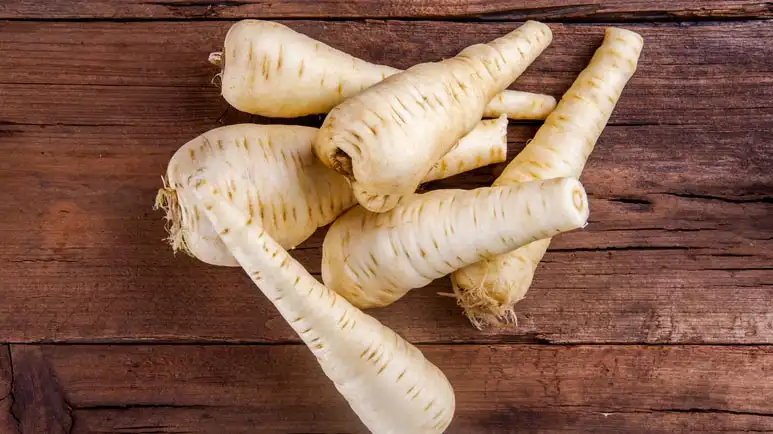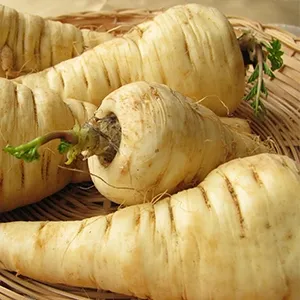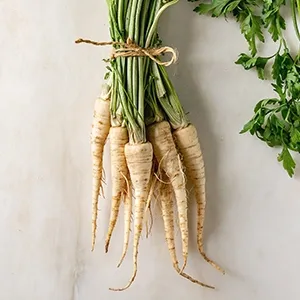Parsnips: This Odd Crop's Secret Blows Vets Away
While you may enjoy it roasted, spiced or baked with a bit of honey or curry, this humble vegetable is best shared plain — either raw or cooked — to your furry friend. Has your pet tasted them yet?

STORY AT-A-GLANCE
- Parsnips have a naturally nutty or earthy flavor, with a hint of sweetness, like a carrot. This crunchy vegetable has plenty to offer, including vitamins C, K and folate, as well as antioxidants, which can all benefit your digestive health and immunity
- Many of its benefits come from its wide array of phytochemicals, including the flavonols kaempferol and quercetin, which have immune-boosting, antioxidant, cancer-protective and cardioprotective benefits for you and your pet
- The phytochemicals falcarinol (FaOH) and falcarindiol (FaDOH), which are unique to the Apiaceae plant family, also have anti-inflammatory and antifungal activities
- Research shows that the FaOH and FaDOH in parsnips also have potential anticancer effects. FaDOH has also been shown to have positive metabolic effects
- Add small amounts of parsnips to your pet's meal. Cut them up into small, bite-sized pieces to prevent any choking hazard
Editor's Note: This article is a reprint. It was originally published December 14, 2023.
When it comes to a festive holiday dinner, side dishes are always a must-have, and one of the most popular is roasted parsnips. Usually made with a honey glaze or infused with spices, parsnips are loved for their earthy, nutty flavor that goes well with different types of dishes. If you have a few pieces left over, here's something you can do: Add them to your pet's meal!
What Are Parsnips and Why Are They Good for Pets?
Often mistaken for a white carrot, parsnips (Pastinaca sativa) are cream-colored root vegetables that belong to the parsley plant family (Apiaceae). Long and tapered, they're available during the cold seasons, fall and winter, which is why you often see them during holiday celebrations. Parsnips have a natural hint of sweetness, like a carrot.1 They can be boiled, steamed, sauteed and roasted — this is the way most people serve this vegetable, as roasting enhances their sweetness.
In terms of nutrition, parsnips also have plenty to offer, including vitamins C, K and folate, as well as antioxidants, which can all benefit your digestive health and immunity. They're also high in fiber — in fact, they have more than twice the amount of fiber as turnips, another vegetable they're often compared to.2,3
All these nutrients can have an immense impact on your pet's well-being. Hence, parsnips can be a good addition to your pet's biologically appropriate, nutritionally balanced meals or homemade treats.
Did You Know?

Parsnips taste better in the winter! During the frosty weather, the stored starches in the veggie are released and then broken down — a survival mechanism as the sugars protect the plants' cells and make them less likely to freeze. This gives them a sweeter flavor.4
Parsnips Offer Phytochemicals That Boost Immunity
Aside from its culinary uses, parsnips also have nutritional and therapeutic applications. Many of its benefits come from its wide array of phytochemicals, including the flavonols kaempferol and quercetin, which have immune-boosting, antioxidant, cancer-protective and cardioprotective benefits for you and your pet.5,6
Quercetin and kaempferol also have antimicrobial benefits that can inhibit pathogenic microorganisms. One study even notes that kaempferol can inhibit the harmful effects of Staphylococcus aureus bacteria.7 According to the researchers, "Kaempferol provides a starting point for the development of novel anti-biofilm drugs, which may decrease the risk of bacterial drug resistance, to prevent S. aureus biofilm-related infections."
Meanwhile, quercetin is known as "nature's Benadryl" for its ability to help ease allergy symptoms, thanks to its antihistamine effects.8 In a 2019 study involving 17 dogs with atopic dermatitis, quercetin was one of the nutrients included in the dermatologic diet fed to the participants, and they demonstrated marked improvement after being fed this type of diet.9
Parsnip Fun Fact

In the U.K., parsnips were once used in cakes and jam as a sweetener, before sugar beets were cultivated. During the 1600s, they were also considered an aphrodisiac.10
Distinct Compounds in Parsnips — Falcarinol and Falcarindiol
Two potent phytonutrients in parsnips that offer additional benefits are falcarinol (FaOH) and falcarindiol (FaDOH), which are unique to the Apiaceae plant family.11 These two polyacetylenic oxylipins have anti-inflammatory and antifungal activities, and even potential anticancer effects that may benefit your pet, and there are several studies that support this notion.12
In a 2019 animal study conducted on rats, researchers found that falcarinol and falcarindiol demonstrated a chemopreventive effect against colorectal cancer (CRC). The study authors said:13
"The CRC protective effects of apiaceous vegetables are mainly due to the inhibitory effect of FaOH and FaDOH on NF-κB and its downstream inflammatory markers, especially COX-2 ...
The present study suggests the need for precise dietary advice to prevent CRC, and to develop new selectively COX-2 inhibitors with no or only minor side effects."
A separate 2012 study noted that falcarindiol "preferentially kills colon cancer cells but not normal colon epithelial cells." It also helps inhibit tumor growth and shows "strong synergistic killing of cancer cells" when used along with a chemotherapy drug.14
As for falcarinol, an animal study notes that aside from its anticancer effects, it may also have positive metabolic effects and improves insulin signaling among insulin-resistant porcine subjects. Falcarinol may have benefits for inflammation-related issues in the gastrointestinal tract as well. According to the authors:15
"The efficacy of FA [falcarinol] may be fruitful to explore for prevention and treatment in inflammatory pathologies of the GI tract and in supporting the maintenance of intestinal barrier integrity."
What Are the Top Parsnip-Growing States in the US?

In the U.S., Michigan, New York, Oregon and Washington are the top parsnip-growing states. In Canada, Quebec and Ontario are the main areas where this root vegetable grows.16

How to Feed Parsnips to Your Pet
There's a lot of misinformation about healthy fruits, vegetables, nuts and seeds all over the internet, mostly because websites have labeled all risks (such as the risk of overconsumption causing gastrointestinal issues, or choking on too large of pieces or pits) as "toxicities." Not all of these are true, yet they've managed to confuse millions of pet lovers, nonetheless.
In the case of parsnips, one common concern among pet parents is that it may cause gastrointestinal issues and upset stomach. However, this may only occur if your pet has ingested a large amount of parsnips in one sitting (as in adding 3 to 4 cups at a time, if your pet has never consumed them). To keep this from happening, make sure to only add small amounts of parsnips to your pet's meal, as a treat. Cut them up into small, bite-sized pieces to prevent any choking hazard.
Parsnips are not on the Environmental Working Group's 2024 Dirty Dozen list,17 so it may be safe to feed conventional varieties. However, if organic, spray-free options are available in your area, opt for those instead. Parsnips can be fed raw or cooked, and they can be used as toppers to pet meals or given as training treats. Just make sure that when given as treats, parsnips should only make up 10% of your dog's daily caloric intake.
Are Parsnips Sustainable?
According to HEALabel, parsnip production is "relatively sustainable" as it does not lead to significant damage to land, air, water, soil and forests. This crop also has a relatively low carbon footprint compared to other foods. To grow 1 kilogram (2.2 pounds) of this starchy root, 0.4 kilogram of CO2e is produced, which is equivalent to a car driving a mile. At least 387 liters (46 gallons) of water is also used.18
Sources and References
- 1 Real Simple, September 1, 2024
- 2 USDA Food Data Central, Turnips, raw
- 3 USDA Food Data Central, Parsnips, raw
- 4 Kew, December 17, 2020 (Archived)
- 5,12 Canadian Academy of Sports Nutrition, January 1, 2024
- 6 USDA, Flavonoid Content of Vegetables
- 7 Front Microbiol. 2017 Nov 15;8:2263
- 8 Native Pet, May 18, 2023
- 9 BMC Vet Res. 2019 Jun 28;15(1):220
- 10 Crop Drop, Parsnips (Archived)
- 11,13 Nutrients. 2019 Sep 14;11(9):2223
- 14 Cell Death & Disease Volume 3, Page e376, August 23, 2012
- 15 Oxid Med Cell Longev. 2019; 2019: 3765986
- 16 Fresh Plaza, April 3, 2015
- 17 EWG's 2024 Shopper's Guide to Pesticides in Produce
- 18 HEALabel, January 3, 2023











